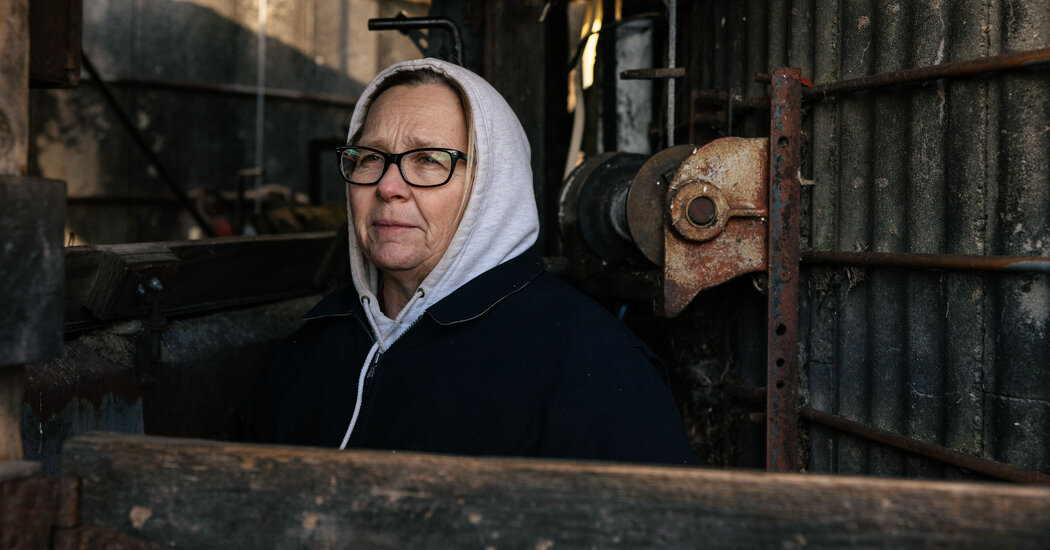LOGANVILLE, Wis. — Brenda Statz remembers the rain on the day they lost Leon, her husband of 34 years. The deluge had fallen for weeks, flooding their fields, delaying the harvest, pounding the roof of the barn where Mr. Statz finished his morning chores, then ended his life.
It was Oct. 8, 2018, a Monday. Mr. Statz, father of three, grandfather of one, was 57. A note in the pocket of his work pants described how depression had robbed him of the hope and pride he had in running a third-generation dairy farm.
Most families Mrs. Statz knew suffered such losses in isolation, silenced by the stigma surrounding mental illness. “But I was compelled to talk about it,” Mrs. Statz said. Soon after her husband’s death she and several friends founded the Farmer Angel Network, connecting struggling farmers and their families with help, and with each other.
The rate of suicide among farmers is three and a half times higher than among the general population, according to the National Rural Health Association. Suicide rates in rural communities increased by 48 percent between 2000 and 2018, compared with 34 percent in urban areas.
“Our producers are constantly expected to do more with less, innovate and improve, raise a family, preserve a legacy — and let’s not forget feeding and clothing the world while we’re at it,” Zach Ducheneaux, the administrator of the Farm Service Agency, the federal government’s main conduit for financial support to agriculture, wrote last summer.
The average farmer in America is male and around 57 years of age, as Mr. Statz was, although more women and younger people have entered farming over the past decade. Men in general are more likely to die by suicide, and full-time farmers face intense financial pressure, their livelihoods affected by global forces outside their control like trade wars and livestock pandemics.
Raised to value stoicism and self-determination, they often avoid seeking mental health treatment out of shame, and the erroneous notion that depression is not an illness but a state of mind fixable through attitude, faith or hard work.
Senator Tammy Baldwin, Democrat of Wisconsin, is seeking $10 million in the 2023 farm bill — the same level as authorized in the 2018 farm bill — for an Agriculture Department stress assistance network that helps fund behavioral health services for rural Americans. Ms. Baldwin was the lead sponsor of legislation to create a 988 number to reach the Suicide & Crisis Lifeline, which last year replaced the decades-old 10-digit number, and she helped secure $3.1 million from the government to support the 988 line’s rollout in her state.
“We can and must do more,” Ms. Baldwin said in a statement.
The National Rural Health Association agrees. Last month the association, whose 21,000 members include rural hospitals and clinics, wrote to leaders of the House and Senate agricultural committees demanding greater attention to what its chief executive, Alan Morgan, called “a deep-seated and longstanding problem.”
The association wants Congress to increase the stress assistance network’s funding to $15 million annually in the farm bill, and make it permanent. The group is also calling for a national crisis line tailored to agricultural workers, separate from the 988 number.
“It’s impossible to overstate the rural and urban difference when it comes to seeking behavioral health care,” Mr. Morgan said.
‘He Thought He Failed’
The Statz family farm is in the Driftless Area, a fertile, rolling swath of Wisconsin, Illinois, Minnesota and Iowa untouched by ice age glaciers and the rocky “drift” they left as they retreated. A sign out front proudly announces years of awards for dairy production.
Mr. Statz’s life revolved around the 200-acre farm, an operation kept small enough so that the family could work it without outside help. Mr. Statz’s parents had lived and worked on the farm. The couple’s sons, Tom and Ethan, farmed with their father part-time, as did Mrs. Statz, who also works in a Lands’ End distribution center in nearby Reedsburg.
Mr. Statz was sociable and adventurous. He used to ride a motorcycle when he and Mrs. Statz were dating, and when he turned 50 he bought two of them, including a vivid green Harley-Davidson. On weekends the couple sometimes rode up to Wildcat Mountain State Park, which overlooks the Kickapoo River valley. In summer they invited relatives and friends over for Mr. Statz’s grilled onion burgers and beer, and in winter they threw parties whose price of admission was a donation to their church food pantry. Their farm was a home away from home for friends of their sons and daughter, Sarah.
“You never knew on a Friday night who would be sleeping here, on the couches, chairs or wherever,” Mrs. Statz recalled.
Unknown to most in their orbit, Mr. Statz had bouts of depression for three decades. Their children were infants when he first sought help from the family’s doctor.
“He basically told Leon to ‘chin up and face it like a man — in a year, you’ll laugh at it,’” Mrs. Statz recalled. “I will never forget that. Because then Leon’s like, ‘Now it falls back on me again. It’s my fault I can’t get out of this.’”
Mrs. Statz said her husband took medication for his depression periodically, and had done well for years on it. “But any time there was a major change, that’s when I could see it coming,” she said.
In late 2017 the family sold their prized Holstein cattle. As part of a plan to bring the couple’s two sons more fully into the business, they went into grain and beef farming, which is less labor-intensive than milking cows twice daily. It allowed their sons to keep part-time jobs off the farm, but it was a riskier endeavor than milk production because it involves heavy upfront costs for seed and fertilizer, with a paycheck dependent on a distant, uncertain harvest.
The transition plunged Mr. Statz into paralyzing anxiety. He grew convinced the farm was going under. No amount of reassurance from his family or their bankers, Mrs. Statz said, could convince him that the farm was in fact prospering.
Mr. Statz sought part-time work off the farm to help tide the family over before the harvest. Offered good-paying jobs at a local valve company and as a forklift operator, he instead signed on as a meat cutter in a local supermarket. It was low-paid, dangerous work. “He finally admitted why he took that job,” Mrs. Statz recalled. “Because he thought he failed, and he needed to punish himself.”
Four months after selling the cows, Mr. Statz made his first suicide attempt. He called his children to say goodbye, swallowed a handful of pills and sealed himself into a shed, with farm equipment running inside.
“I wish I never sold (our, my) cows! I’m a dairy farmer,” Mr. Statz wrote in a note to his family. “I want my old life back, but I can’t get it anymore. Every thing I do fails. I didn’t plan ahead for this … I really screwed up! I have everything that’s worth nothing!”
Mrs. Statz heard the equipment from the house. She tangled with Mr. Statz while trying to shut it down and open the shed’s overhead doors, to let air inside. She summoned the police and their pastor. Mr. Statz was involuntarily hospitalized for three days in Winnebago, more than two hours away.
He returned home still anxious, and with an extensive medication regime. Mrs. Statz, deeply shaken, was uncertain about how to care for him, what to watch for or what to say. She recalled sitting with him in the car outside their church, St. Peter’s Lutheran in Loganville, on a Sunday soon after his hospitalization. Her husband was ashamed to go inside.
Their pastor, the Rev. Donald Glanzer Jr., had just lost a close friend to depression. “We were all pulling for Leon,” he said. But Mr. Statz was reluctant to share his struggles. “If a couple hundred acres need combining, farmers will ask for help,” Pastor Glanzer said. “But anything to do with their emotional makeup or personal psychology, they usually don’t.”
In the summer of 2018, Mr. Statz’s son Ethan found him in the haymow, fashioning a noose. Hospitalized this time in the state capital of Madison, 60 miles away, Mr. Statz underwent electroconvulsive therapy. Halfway through, “he came home and he was like himself — he was old Leon,” Mrs. Statz recalled. “And I’m like, wow. This is working. He’s maybe going to pull out of it now.”
Mr. Statz’s doctors canceled the rest of the therapy, but two weeks later “we were back to square one,” Mrs. Statz said. They restarted the treatments, but his condition did not improve.
Mr. Statz described to his wife how he felt: “Like you’re in the bottom of this hole, this pit, and you can see the top and you’re climbing, climbing, and struggling your way to the top. And just when you get to the top, it goes higher, and you keep climbing, and pretty soon you get tired and you can’t climb anymore.”
On that October morning in 2018, Ethan found his father dead in the heifer shed, his raincoat draped neatly over a door nearby.
‘Come and Talk’
Mr. Statz was buried in jeans and his favorite Harley Davidson shirt and belt. In his obituary, the Statz family departed from convention. They did not write that he died “tragically” or “suddenly,” but “after a long-fought battle with depression.” They included a phone number for the county crisis line. “We needed to get the word out,” Mrs. Statz said. “He wasn’t weak or a failure. He was sick.”
In his sermon, Pastor Glanzer called on the congregation to acknowledge the illness that led to Mr. Statz’s death, and to recognize it among others.
“Leon’s life was a wonderful tapestry, every thread in place. But if you turn the tapestry to the backside, it was a frightening array of thread and knots and frayed ends and stray threads,” the pastor recalled saying. “Even though that’s not as good, it’s as equal a part of our life as the beautiful tapestry that everyone else sees.”
At a lunch after the service, friends of Mr. Statz approached Pastor Glanzer about doing something to help others, “so it doesn’t happen again,” he recalled.
They decided to hold Wednesday meetings once a month in the church hall — “a place to come in and be among other farmers, if you just want to come and talk, listen, whatever,” Mrs. Statz said. They enlisted Pam Jahnke, the “Fabulous Farm Babe” on a regional farm radio station, to spread the word on her popular morning report.
Church volunteers set out free soup and sandwiches. Mrs. Statz expected 15 people to show up. Instead 40 came. A woman whose brother died by suicide talked about the warning signs. Frank Friar from the Wisconsin Farm Center offered free counseling vouchers and financial planning for farmers in stress. A man from the region’s Amish community offered free bookkeeping for farmers in trouble. Others rose to offer help with milking, planting and harvesting for neighbors who need a break.
That first meeting was only three months after Mr. Statz’s death, and “I didn’t know if I could speak his name,” Mrs. Statz said. But she did speak, and has done so nearly every day since. The meetings grew into the Farmer Angel Network, funded through donations from individuals, local businesses and groups.
“You can’t always be the tough guy and get it done yourself,” Mrs. Statz said. “Sometimes you say, ‘You know what? Yeah, I could use some help.’”
If you are having thoughts of suicide, call or text 988 to reach the Suicide and Crisis Lifeline, or go to SpeakingOfSuicide.com/resources for a list of additional resources.



